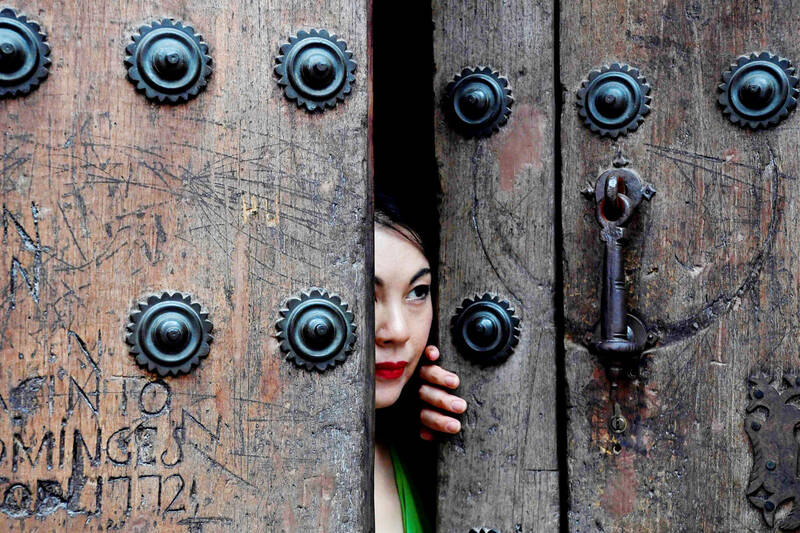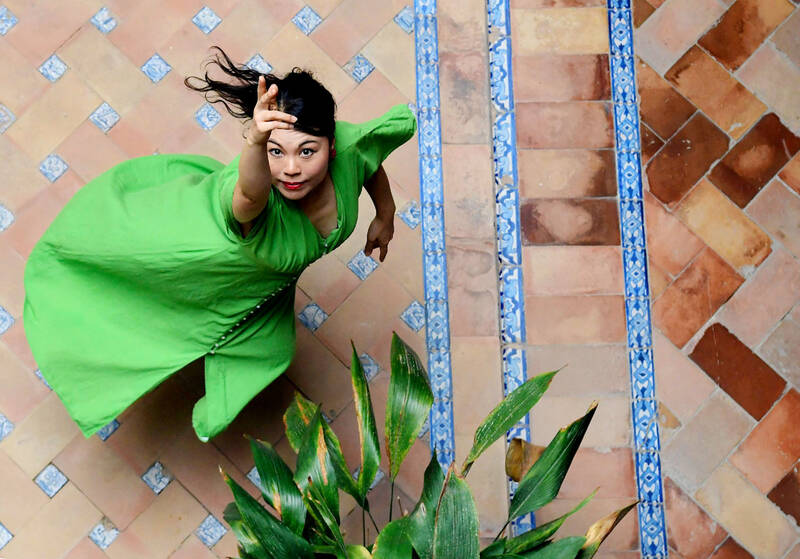Japan’s Junko Hagiwara has caused a stir in Spain’s traditional flamenco world by unexpectedly winning the prize for best dancer at the country’s leading flamenco festival — the first foreigner to do so. The announcement that the 48-year-old — who performs under the stage name “La Yunko” — was awarded the honor at the closing ceremony of last month’s Cante de las Minas festival in the southeastern town of La Union was met with a mixture of applause and some jeering.
“I was very surprised, I could not believe it. I believed it but I did not believe it,” she said by phone from the southern city of Seville, where she has lived for over two decades when asked about her reaction to getting the award.
Hagiwara, who was born in Kawasaki near Tokyo, said she did not notice the jeers because she “went blank” when her name was announced as the winner.

Photo: AFP
“When I dance, I don’t think I am a foreigner, that I am Japanese. I don’t think that. It doesn’t occur to me. I am simply on stage, I listen to the guitar, the singing and what I feel I express in my dancing,” she added.
Created in 1961, the Cante de las Minas festival is considered to be the world’s most important annual flamenco festival. It features prizes for best singing, guitar playing and musical instrument performance in addition to dance. Critics were unanimous in their support for Hagiwara.
“I liked her more than her competitors for three reasons: her classicism, the fact that she did not dance for the gallery, that is, for the public, and, finally, her good training,” flamenco critic Manuel Bohorquez wrote in online newspaper Sevilla Info.

Photo: AFP
Hagiwara said she became fascinated by flamenco — a centuries-old art form that combines rhythmic hand clapping, stamping feet and impassioned singing — at age 14 when she watched a gymnastics championship in which a Spanish competitor used the genre’s guitar music.
“I loved the flamenco guitar, the sound and the melody, the rhythm,” she said.
There was no Internet at the time to help her explore her new interest, so she went to a shop that rented records and borrowed the only available flamenco CD. “I listened to it, but there was no guitar, it was just singing,” she recalled.
“Flamenco performers often have a very hoarse voice, very deep, and it scared me,” she added while laughing.
Hagiwara went on to study pedagogy at Waseda University in Tokyo, where she joined a flamenco club, and started to take flamenco lessons. But she felt she needed more. In 2002, she decided to take the dramatic move across the world to Seville, capital of the southern region of Andalusia and the cradle of flamenco, to pursue her passion.
She made the move despite objections from her parents.
“In Japan, you can learn technique, choreography, but, of course, flamenco is culture, it’s a way of life,” she said.
“My father got very, very angry. He did not speak to me for three months. And my mother said ‘how shameful, how shameful’,” Hagiwara said.
In Spain, she dedicated herself to flamenco, learning to dance with the best teachers, became fluent in Spanish and married an Andalusian man from the coastal town of Tarifa.
She gradually made a name for herself as a performer in Seville, and has also taught flamenco.
As is the case with many foreigners, she was surprised at first by the lively way locals talked to each other.
“I thought everyone was fighting!” Hagiwara said.
There were other differences.
“In Japanese culture, we place a lot of value on hiding the feeling, and in flamenco, you have to show it. In Japan it is for the inside, and in flamenco it is for the outside,” she said.

That US assistance was a model for Taiwan’s spectacular development success was early recognized by policymakers and analysts. In a report to the US Congress for the fiscal year 1962, former President John F. Kennedy noted Taiwan’s “rapid economic growth,” was “producing a substantial net gain in living.” Kennedy had a stake in Taiwan’s achievements and the US’ official development assistance (ODA) in general: In September 1961, his entreaty to make the 1960s a “decade of development,” and an accompanying proposal for dedicated legislation to this end, had been formalized by congressional passage of the Foreign Assistance Act. Two

Despite the intense sunshine, we were hardly breaking a sweat as we cruised along the flat, dedicated bike lane, well protected from the heat by a canopy of trees. The electric assist on the bikes likely made a difference, too. Far removed from the bustle and noise of the Taichung traffic, we admired the serene rural scenery, making our way over rivers, alongside rice paddies and through pear orchards. Our route for the day covered two bike paths that connect in Fengyuan District (豐原) and are best done together. The Hou-Feng Bike Path (后豐鐵馬道) runs southward from Houli District (后里) while the

March 31 to April 6 On May 13, 1950, National Taiwan University Hospital otolaryngologist Su You-peng (蘇友鵬) was summoned to the director’s office. He thought someone had complained about him practicing the violin at night, but when he entered the room, he knew something was terribly wrong. He saw several burly men who appeared to be government secret agents, and three other resident doctors: internist Hsu Chiang (許強), dermatologist Hu Pao-chen (胡寶珍) and ophthalmologist Hu Hsin-lin (胡鑫麟). They were handcuffed, herded onto two jeeps and taken to the Secrecy Bureau (保密局) for questioning. Su was still in his doctor’s robes at

Mirror mirror on the wall, what’s the fairest Disney live-action remake of them all? Wait, mirror. Hold on a second. Maybe choosing from the likes of Alice in Wonderland (2010), Mulan (2020) and The Lion King (2019) isn’t such a good idea. Mirror, on second thought, what’s on Netflix? Even the most devoted fans would have to acknowledge that these have not been the most illustrious illustrations of Disney magic. At their best (Pete’s Dragon? Cinderella?) they breathe life into old classics that could use a little updating. At their worst, well, blue Will Smith. Given the rapacious rate of remakes in modern